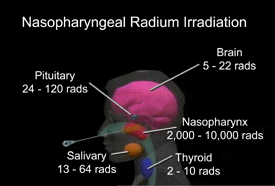NRI: General Information
Description
From 1940 through the mid to late 1960s, NRI was used to treat hearing loss, chronic otitis, and other conditions among children. It was also used by the military to treat aerotitis media in submariners and aviators. Before 1950, NRI was one of several radiation treatments used to treat benign conditions. Other treatments included use of external x-irradiation to treat hearing loss, acne, tinea capitis, enlarged adenoids, and enlarged thymus, and the use of topical radon and radium to treat hemangiomas. This treatment was discontinued because alternative treatments were developed (T-tubes and better antibiotics) and because of concern about possible radiation carcinogenesis.
Who received the treatment
An estimated 500,000 to 2 million civilians were treated. Treatments began as early as 1940 and continued until the mid to late 1960s. The majority of these civilians were children at the time of treatment. Most of the patients were born before 1960, with the peak use of NRI most likely among children who were born between 1940 and 1950. More than 8,000 World War II servicemen also received NRI.
Typical Treatment description
The goal of treating an individual with NRI was to reduce swollen tissues surrounding the opening of the eustachian tubes. It was thought that reducing the amount of swollen tissue would allow the ears to drain, thereby preventing chronic ear infections that could lead to hearing loss. Typical treatments lasted from 6 to 12 minutes and were commonly repeated at 2 to 3 week intervals with a total of 3 treatments being administered. Occasionally a second course of 3 treatments was given.
Reason for use
NRI was used for areas in which surgeons could not operate. It did not require general anesthesia or hospitalization. NRI was felt to be a safer treatment than conventional X-ray.
Top of Page
Conditions treated with NRI
Primary Conditions
- Hearing loss
- Aerotitis media
- Middle ear barotrauma
Other Conditions
- Sinusitis
- Asthma
- Repeated viral and bacterial infections
- Recurrent tonsillitis
- Recurrent acute otitis media
- Chronic otitis media
Top of Page
Radiation doses
Radiation doses among adults to nearby organs were estimated on the basis of 50 mg of radium sulfate in two 0.5 mm platinum capsules for 12 - 60 minutes per session for three sessions.

Top of Page
Estimates of Doses
- 2,000 - 10,000 rads to the mucosal lining of the nasopharynx
- 24 - 120 rads to the pituitary gland
- 13 - 64 rads to the salivary gland
- 5 - 22 rads to the brain
- 2 - 10 rads to the thyroid
Since most of the radiation from nasopharyngeal radium was in the form of beta particles, the highest dose was delivered to the soft tissue of the nasopharynx. However, the background rate of cancer of the nasopharynx is low (0.6 per 100,000 persons) and there is no documented evidence that the nasopharynx is as sensitive to radiation as thyroid or brain tissue.
Top of Page
- Page last reviewed: January 7, 2014
- Page last updated: August 19, 2010
- Content source:


 ShareCompartir
ShareCompartir